Multifunctional adaptive NS1 mutations are selected upon human influenza virus evolution in the mouse
- PMID: 22363747
- PMCID: PMC3283688
- DOI: 10.1371/journal.pone.0031839
Multifunctional adaptive NS1 mutations are selected upon human influenza virus evolution in the mouse
Abstract
The role of the NS1 protein in modulating influenza A virulence and host range was assessed by adapting A/Hong Kong/1/1968 (H3N2) (HK-wt) to increased virulence in the mouse. Sequencing the NS genome segment of mouse-adapted variants revealed 11 mutations in the NS1 gene and 4 in the overlapping NEP gene. Using the HK-wt virus and reverse genetics to incorporate mutant NS gene segments, we demonstrated that all NS1 mutations were adaptive and enhanced virus replication (up to 100 fold) in mouse cells and/or lungs. All but one NS1 mutant was associated with increased virulence measured by survival and weight loss in the mouse. Ten of twelve NS1 mutants significantly enhanced IFN-β antagonism to reduce the level of IFN β production relative to HK-wt in infected mouse lungs at 1 day post infection, where 9 mutants induced viral yields in the lung that were equivalent to or significantly greater than HK-wt (up to 16 fold increase). Eight of 12 NS1 mutants had reduced or lost the ability to bind the 30 kDa cleavage and polyadenylation specificity factor (CPSF30) thus demonstrating a lack of correlation with reduced IFN β production. Mutant NS1 genes resulted in increased viral mRNA transcription (10 of 12 mutants), and protein production (6 of 12 mutants) in mouse cells. Increased transcription activity was demonstrated in the influenza mini-genome assay for 7 of 11 NS1 mutants. Although we have shown gain-of-function properties for all mutant NS genes, the contribution of the NEP mutations to phenotypic changes remains to be assessed. This study demonstrates that NS1 is a multifunctional virulence factor subject to adaptive evolution.
Conflict of interest statement
Figures
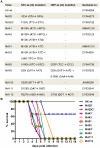

 NS1 mutant M106V + M124I was inoculated at dose of 2.5×106 PFU due to insufficient viral stock titre. Survival (A) and body weight loss (B) were monitored for 14 dpi. Percent body weight is expressed as the mean value of 5 (or total number alive) mice (*p<0.05, **p<0.01, ***p<0.001; two-tailed unequal variance paired student's t-test for days 1–6). Experimental endpoint was defined as >30% body weight loss and respiratory distress. Graphical analysis of data was broken into three mutant sets, with rHK-wt included in each, due to the number of mutants surveyed.
NS1 mutant M106V + M124I was inoculated at dose of 2.5×106 PFU due to insufficient viral stock titre. Survival (A) and body weight loss (B) were monitored for 14 dpi. Percent body weight is expressed as the mean value of 5 (or total number alive) mice (*p<0.05, **p<0.01, ***p<0.001; two-tailed unequal variance paired student's t-test for days 1–6). Experimental endpoint was defined as >30% body weight loss and respiratory distress. Graphical analysis of data was broken into three mutant sets, with rHK-wt included in each, due to the number of mutants surveyed.

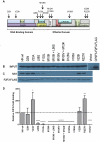
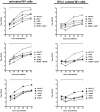

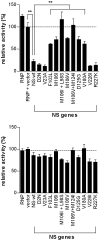


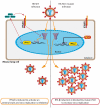
References
-
- Webster RG, Hulse-Post DJ, Sturm-Ramirez KM, Guan Y, Peiris M, et al. Changing epidemiology and ecology of highly pathogenic avian H5N1 influenza viruses. Avian Dis. 2007;51(1 Suppl):269–272. - PubMed
-
- World Health Organization. 2011. Cumulative number of confirmed human cases for avian influenza A(H5N1) reported to WHO, 2003–2011. 2011(17 October, 2011)
Publication types
MeSH terms
Substances
Associated data
- Actions
- Actions
- Actions
- Actions
- Actions
- Actions
- Actions
- Actions
- Actions
- Actions
- Actions
- Actions
Grants and funding
LinkOut - more resources
Full Text Sources
Other Literature Sources
Medical
Miscellaneous

